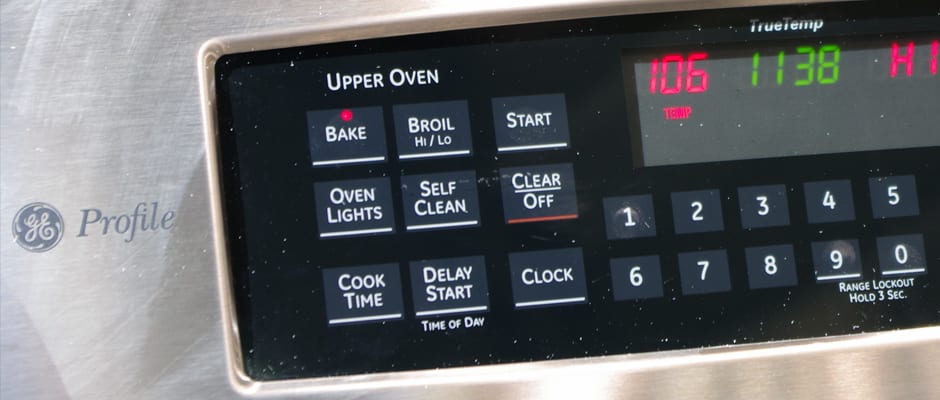Introduction
Front
{{section_header}}{{section.name}}{{/section_header}}
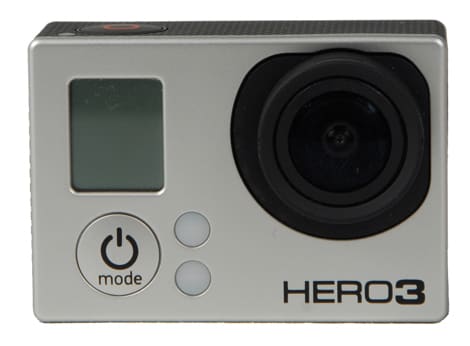
Range-top
{{section_header}}{{section.name}}{{/section_header}}
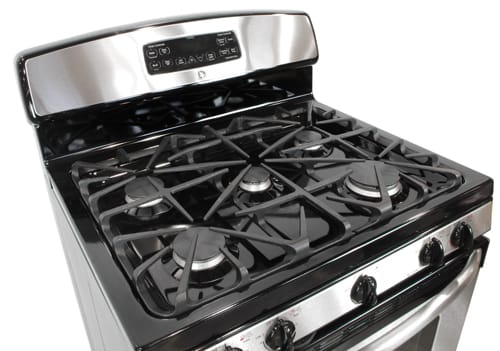
Upper Oven
{{section_header}}{{section.name}}{{/section_header}}
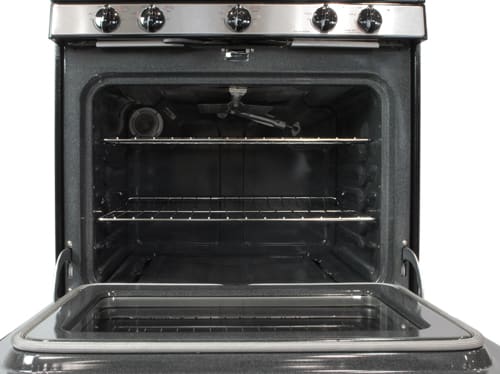
Lower Oven
{{section_header}}{{section.name}}{{/section_header}}

Cooking Performance
The {{product.name}} had good performance in most of our tests, where it boiled water quickly, achieved high temperatures from the elements and produced consistent temperatures in the ovens. However, we found that the oven could not produce the high temperatures that we look for, and the broiler was slow to heat up.
{{photo_gallery "Primary Oven Keep-Warm Ramp-up", "Primary Oven 350F Ramp-up", "Primary Oven Max Ramp-up", "Secondary Oven Convection Ramp-up", "Oven Temperature Variance", "Range-top Water Boil", "Range-top Temperature Range"}}
Range Performance Overall
{{section_header}}{{section.name}}{{/section_header}}
The five electric heating elements can produce high temperatures, but they struggled to boil water at high speeds.

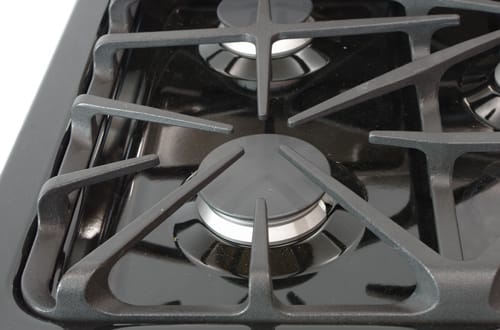
Water Boiling
{{section_header}}{{section.name}}{{/section_header}}
Boiling water is one of the most basic tasks that a range has to perform, so we test how quickly all of the ovens that we review can boil a pot of water. This range did reasonably well, boiling a small pot of water in just under 9 minutes and a larger pasta pot in under 24 minutes.
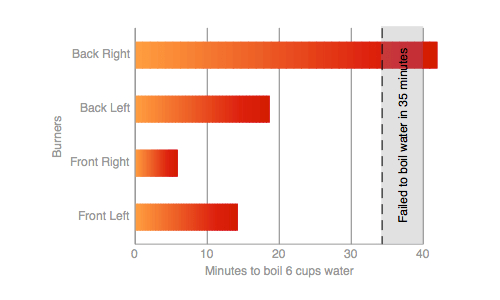
Don't try to boil with the back right simmer burner.
Low Temperature Cooking
{{section_header}}{{section.name}}{{/section_header}}
To simmer your soup properly, you need a range that can deliver a low temperature. The {{product.name}} did well here, with the back left element delivering a very low 92°F, and the others all delivering under 130°F.
Range-top Temperature Range
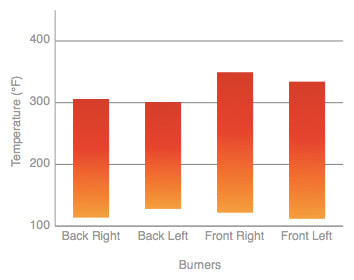
Maximum and minimum heat settings for each burner: The hottest burner reaches about 400F.
High Temperature Cooking
{{section_header}}{{section.name}}{{/section_header}}
At the other end of the temperature range, the maximum temperatures that the elements could deliver was very high: the front right burner delivered a very high 728°F, which is easily enough to sear and quick fry.
Overall Oven Performance
{{section_header}}{{section.name}}{{/section_header}}
The top oven of the {{product.name}} wasn't able to produce the wide range of temperatures that we look for, with the keep warm setting reaching a rather warm 250°F, while the highest setting reached an acceptable 564°F.
{{product.manufacturer_specs['Primary Oven Photo']}}{{photo_gallery "Primary Oven 350F Ramp-up", "Primary Oven Keep-Warm Ramp-up", "Primary Oven Max Ramp-up"}}
Target Temperature Accuracy
{{section_header}}{{section.name}}{{/section_header}}
The range of temperatures is a smaller range than we like to see, with the keep warm setting on the hot side, and the high setting not being all that hot. This range was certainly acceptable, but the keep warm temperature could be an issue, as the rather high temperature could cause the food to dry out.
Temperature Fluctuation
{{section_header}}{{section.name}}{{/section_header}}
Although the temperature range was not as wide as we like to see, we did find that the temperature was very consistent across our tests, with only small variations in the temperature over time.
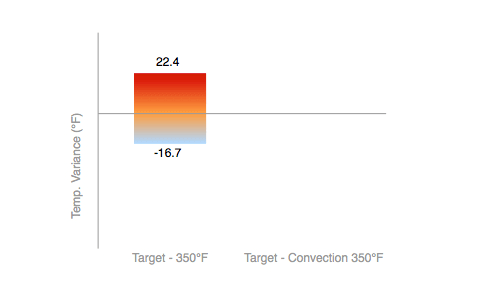
Oven "Margin of Error" in Temperature Variance: The oven is consistent at cool and mid-level temperatures, but inconsistent when operating at its warmest.
Secondary Oven Performance
{{section_header}}{{section.name}}{{/section_header}}
This consistency was further reduced when cooking in the convection mode that the bottom oven offers: here, we found that the typical temperature variation was less than 50°F. That is very low, and should mean good, even cooking of your food.
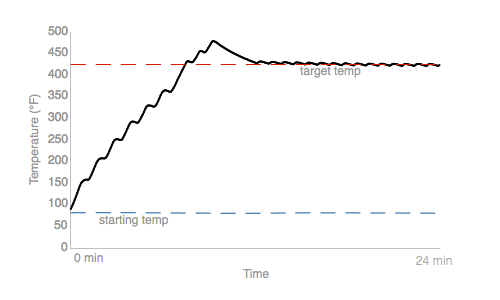
This is the upper divided cavity. After overshooting 425°F, it is ridiculously even.
Broiler Performance
{{section_header}}{{section.name}}{{/section_header}}
The {{product.name}} uses an electric broiler, which we found was rather slow to heat up. We found that after the 16 minutes that we run the tests, the temperature was just under the 608°F that we look for. The broilers on other ovens (particularly the gas models) heat up much quicker, and that makes for quicker cooking.
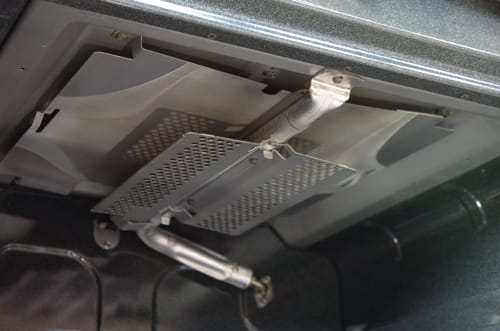
Broiler Features
{{section_header}}{{section.name}}{{/section_header}}
The broiler offers two settings (low and high) and three positions for the broiling rack, which provides a good degree of flexibility in use.
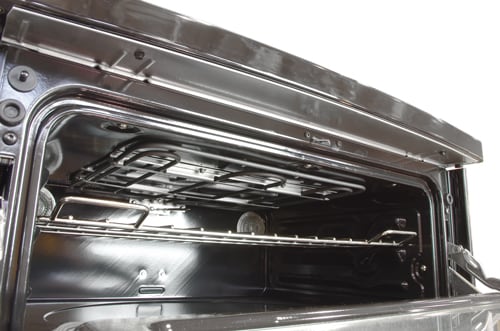
Overall Efficiency
{{section_header}}{{section.name}}{{/section_header}}
The {{product.name}} uses a lot of electricity, sucking down over 11kW for the range and over 17kW for the ovens. That makes it one of the thirstier appliances we have tested, and it would cost more to run than most. That is a consequence of the design: the elements are bigger than most ranges, and draw more power.
Range Efficiency
{{section_header}}{{section.name}}{{/section_header}}
The five elements of the range are rather large, rated at 3,000 Watts for the three segment one, 1,800 Watts for the 7-inch element and 1,500 Watts for the two left rings. In testing, we found that these numbers were a little pessimistic, with the 3-element ring pulling a hefty 4,394 Watts when running at full power.
Oven Efficiency
{{section_header}}{{section.name}}{{/section_header}}
The oven elements are also large and draw a lot of power: GE does not provide a rating for them, but we found that they used a hefty 3,837 Watts for the top and 3,886 for the bottom. Those a rather high numbers, which indicate that this oven will suck down a lot of power when heating up.
Features
{{section_header}}{{section.name}}{{/section_header}}
The range of the {{product.name}} is jam-packed with features, including five elements that provide a wide range of power levels. The smallest is the warming element which is rather underpowered at 180 watts, and the most powerful is the front right ring, which has three separate segments that add up to just under 4300 watts of power. That's a lot, and this explains the excellent performance of this oven in our water boiling tests, where this element boiled a large pasta pan filled with 12.39 oz of water in about 23 minutes: a very impressive time for the largest of our test pans.

There are two ovens on this range, with both using just under 3900 watts of power and capacities of 2.2 and 4.4 cubic feet. That puts it at the high end of the range in terms of capacity: most dual oven models have under 6 cubic feet of total capacity, while this one offers 6.6 cu. ft. The lower oven offers a convection feature, where heated fans circulate the air to produce a more even temperature pattern, which we found to be very effective. There are two racks in the bottom oven and one rack in the top, which
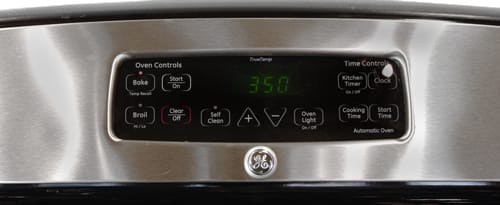
A good selection of timing controls are present on this oven, with the ability to set a delayed start or an interval alarm.
{{product.manufacturer_specs['Timer Photo']}}
Controls
{{section_header}}{{section.name}}{{/section_header}}
It is unusual to see the dials on the top of a range: most put the range top control dials on the front, near the range top itself. This one puts them at the top, though, which is a little awkward: you have to reach over the pans on the range to reach them. This could be a particular problem if you are using large pans or are frying, as it puts your arm right over the hot pan.
The {{product.name}} is not a simple device, but the controls for the 5 range top elements do a good job of breaking the task of controlling these down. The most complex control is for the 3 segment ring on the front right, which is effectively three elements in one. This works by breaking the rotation of the control dial into three segments, which activate one, two or all three segments. Want to just use the center one? Turn it about a third of the way around. Want to use all three? Turn it all the way around. This is a good compromise between simplifying the control and putting multiple features on one dial, and it works well.
The dials themselves are large and easy to turn, with a good latching action that means you are unlikely to accidentally turn them.
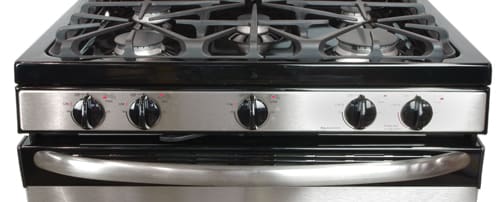
The controls for the oven are located on the panel imbetween the range top dials in two groups: one for each oven. This increases the number of buttons (as some are duplicated), but it also makes the layout more intuitive: you can very easily figure out where the stop button is for each oven. The LCD screen in the center of the panel shows the temperatures for both ovens next to the controls, and the time in the center.
The controls are easy to use, although the sheer number may be somewhat bewildering to older users. Many of the buttons have LED lights above that light up when the feature is enabled, which provides a good way to see what mode the oven is in. This model does not offer any direct access to cooking modes: you have to set the temperature directly yourself.

The broiler is controlled by the same touch buttons as the oven, with the level determined by the number of presses. One press sets them to low, while two presses sets them to hight.
{{product.manufacturer_specs['Broiler Controls Photo']}}
Cleaning
Conclusion
{{product.vanity}}
The {{product.name}} is an electric range that offers a lot of features for the price. That price is on the high side, though: at about ${{product.msrp}}, this is not a product you are likely to buy casually.
The performance is as top-tier as the feature list, though: we found that it boiled water quickly, produced a good range of temperatures from the electric elements on the rangetop and produced consistent oven temperatures. It is also easy to use: more complex features like the 3-stage front right burner are clearly explained by the icons on the control dials, and the layout of the oven & broiler controls makes it easy to work out how to set both running.
We were impressed with this range overall, as it offers a good combination of performance and features for the price. Some users may be slightly overwhelmed by the number of things it can do, but it is easy to use and the features perform well. So, if you want to use electricity as your fuel and are looking for a high-end range that offers good features, this is a good choice.
Meet the tester
Richard Baguley is a veteran writer who has written about technology ranging from Alphabet to Zip file utilities. He has contributed to pretty much every major tech publication, including Amiga Format Magazine, PC World, Wired, CNET, Toms Guide, Forbes, and many others. He lives in the Boston metro area with his wife, dog, and an indeterminate number of cats.
Checking our work.
Our team is here to help you buy the best stuff and love what you own. Our writers, editors, and experts obsess over the products we cover to make sure you're confident and satisfied. Have a different opinion about something we recommend? Email us and we'll compare notes.
Shoot us an email